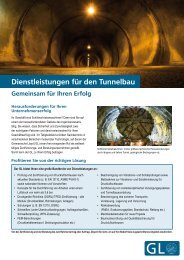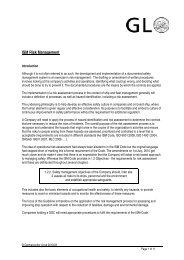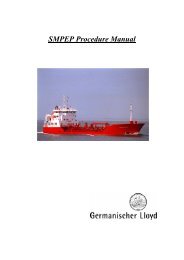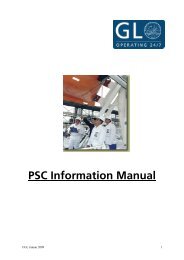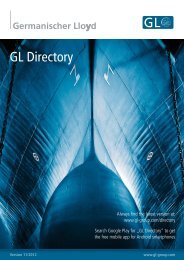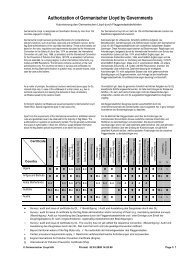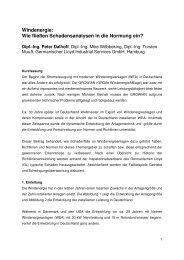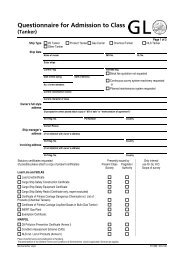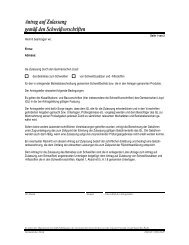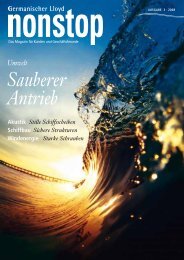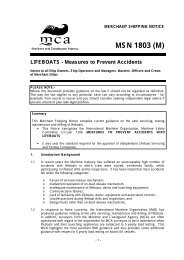Yards Moving Forward - GL Group
Yards Moving Forward - GL Group
Yards Moving Forward - GL Group
Create successful ePaper yourself
Turn your PDF publications into a flip-book with our unique Google optimized e-Paper software.
of pipelines?<br />
in order to identify those parameters critical to the risk of the<br />
whole system. Semi-quantitative methods have been found to<br />
be adequate for such an analysis, enabling the most costeffective<br />
remedial measures to be taken for any identified<br />
risks. Using a stepwise, semi-quantitative method, the riskdriving<br />
parameters and the quantification of the risk for a<br />
pipeline network can be calculated.<br />
<strong>GL</strong> Methodology<br />
The <strong>GL</strong> methodology splits the pipeline system to be<br />
assessed into different sections, called TAGs. Each TAG is<br />
deemed to have a relatively constant risk associated with it<br />
because the physical characteristics of the section and its<br />
environment remain unchanged. However, each change in<br />
the pipe’s wall thickness, or a known damage, for example, or<br />
a change in water depth for an offshore pipeline, would require<br />
a split into different TAGs. Consequence-specific factors<br />
will also impact how a pipeline system is split up into TAGs.<br />
Such factors include pipeline location, volumes transported<br />
and the product being transported. For land pipeline the<br />
location factor would take into account aspects such as population<br />
density, road crossings and the proximity of buildings<br />
for a given area along the route. In addition, the risk assessment<br />
must accommodate any readjustments, such as the<br />
construction of new installations in the vicinity of the pipeline,<br />
that may take place over time.<br />
The <strong>GL</strong> methodology also utilizes an index-based<br />
approach to risk evaluation. Risk is presented by using a risk<br />
matrix to provide a clear overview of the relative contribution<br />
of the probability of failure (PoF) and consequence of failure<br />
(CoF) factors. Considerable effort is required to estimate the<br />
PoF factor and criteria such as design, operation, third party<br />
impact and corrosion are weighed up in the analysis.<br />
Consequences considered in the determination of the CoF<br />
factor include human safety, environmental impact, economic<br />
repercussions and reputational/political fallout.´The<br />
PoF and CoF factors are incorporated in the <strong>GL</strong> Index which is<br />
used to indicate the relative severity of the risk. The highest<br />
risk is when both the PoF and CoF are serious. Risk acceptance<br />
criteria are the limits above which the operator will not<br />
tolerate risk to the installation.<br />
Optimising Pipeline Inspections<br />
Risk acceptance criteria are also used to help determine<br />
the most appropriate type of inspection and the optimum<br />
timing for inspections of relevant parts of the pipeline system.<br />
SAFETY PRECAUTION<br />
Obviously, it is important that an inspection is carried out<br />
prior to the acceptance limit being breached. This could be<br />
likened to preventative maintenance. Timely inspections will<br />
enable not only a reassessment of the risk level based upon<br />
the gathering of firsthand information onsite but also the<br />
detailed evaluation of any damage. Such an evaluation could<br />
necessitate the timely repair or replacement of the degraded<br />
component, i.e. corrective maintenance. The main reason for<br />
implementing a risk-based approach to inspection planning<br />
is to focus inspection efforts on items where the safety, economic,<br />
environmental or reputational risks are identified as<br />
being high. At the same time, inspections of those parts of the<br />
pipeline network identified as low-risk systems can be scaled<br />
down in an appropriate manner.<br />
Software Package<br />
Germanischer Lloyd has incorporated its newly developed<br />
procedure into an RBI software package called GALIOM<br />
for Pipelines. The software not only enables application of the<br />
<strong>GL</strong> methodology to all types of onshore and offshore pipeline<br />
systems but also facilitates the time-consuming iterative processes<br />
for determining the probability and consequences of<br />
failure for each TAG section in a system. This risk-based<br />
evaluation and inspection methodology provides a powerful<br />
tool for improving pipeline inspection strategies. To determine<br />
the risk it is important to consider the time-dependent and<br />
time-independent factors, as both are required for a sufficiently<br />
accurate risk assessment.<br />
Germanischer Lloyd believes that simple qualitative<br />
methods should be replaced with more accurate semi-quantitative<br />
risk evaluation whenever possible. Nevertheless, the<br />
qualitative approach is still required for many technical<br />
aspects because it provides an efficient process for determining<br />
the major contributors to risk. Based on semi-quantitative<br />
methods, the GALIOM for Pipelines risk evaluation and<br />
inspection program enables an accurate assessment of the<br />
probability of failure due to factors such as design, loads, fatigue<br />
and corrosion as well as the consequences. The project<br />
has confirmed that for most pipeline systems corrosion represents<br />
a significant contribution to the overall risk. The <strong>GL</strong><br />
methodology enables an estimation of the probability of corrosion,<br />
the size of flaws and their annual growth rate, taking<br />
into account different boundary conditions as well as inspection<br />
data, if available. The probability index is calculated<br />
using a limit state function for corrosion flaws to provide a<br />
relatively fine graduation of the probability of failure. ■ MC<br />
For further information: Ulrich Adriany, Pipelines and Infrastructure, Deputy Head of Dept.,<br />
Phone: +49 40 36149-7423, ulrich.adriany@gl-group.com<br />
nonstop 3/2006 59





